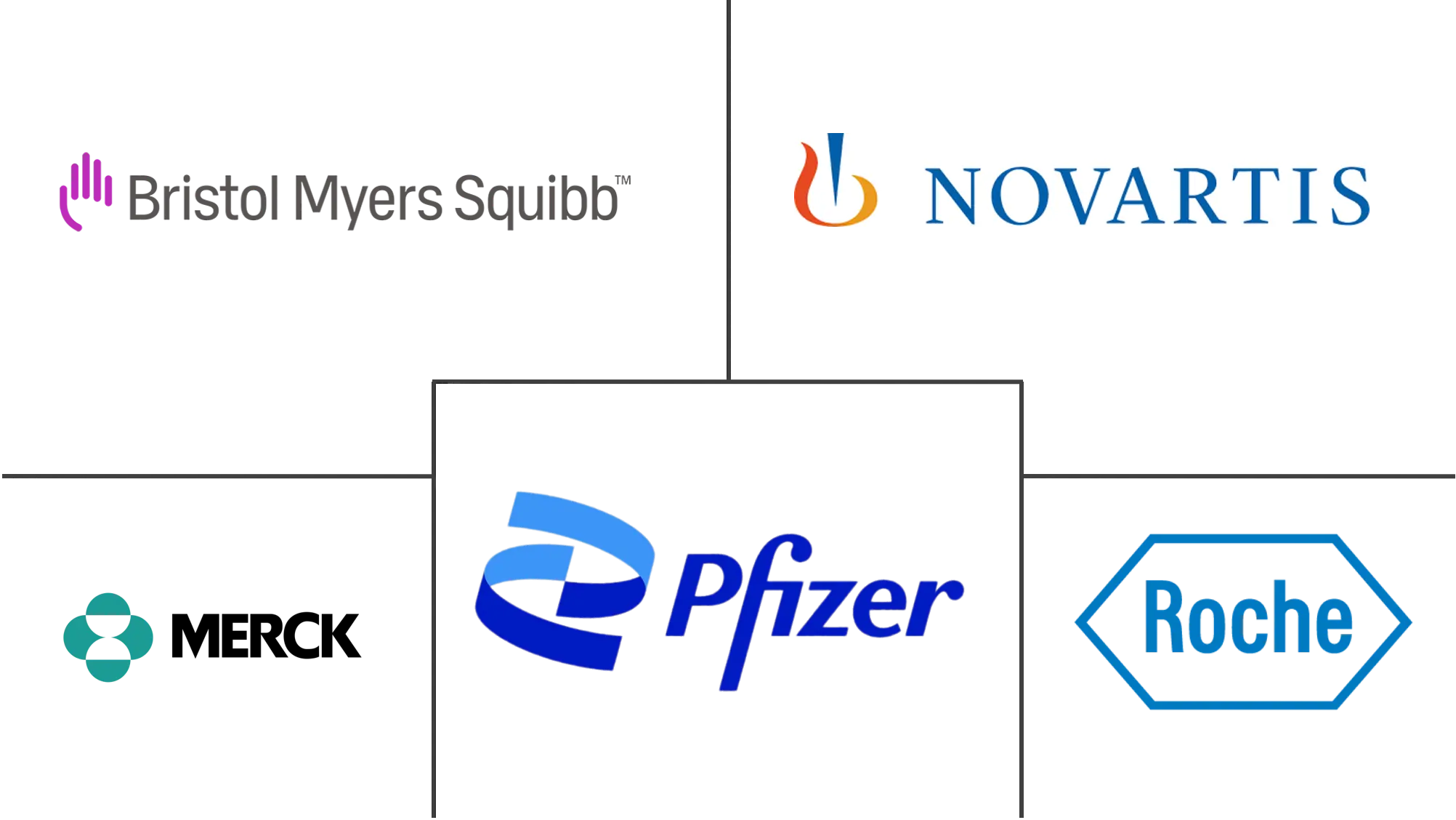Metastatic Melanoma Drugs Market Size and Share
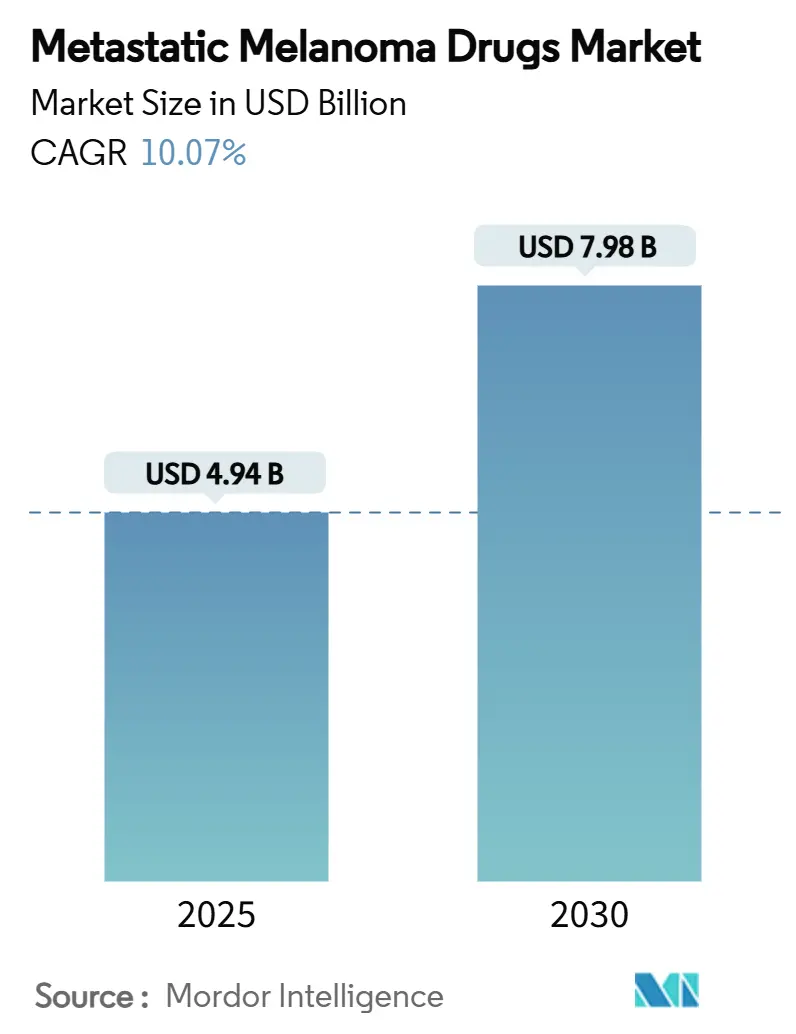
Metastatic Melanoma Drugs Market Analysis by Mordor Intelligence
The metastatic melanoma drugs market size stood at USD 4.94 billion in 2025 and is forecast to reach USD 7.98 billion by 2030, reflecting a 10.07% CAGR across the period. Demand rises on the back of durable immunotherapy responses, next-generation targeted options and wider reimbursement adoption that reduce financial toxicity for patients. Consistent clinical evidence showing decade-long survival benefits with dual checkpoint blockade sustains physician confidence, while pipeline breakthroughs such as tumor-infiltrating lymphocyte therapy expand the armamentarium. Delivery innovation through intratumoral regimens cuts systemic toxicity, and AI-guided discovery tools shorten development timelines. Heightened competition emerges as leading players defend first-line dominance against biotech newcomers introducing oncolytic viruses, bispecific antibodies and radiopharmaceuticals.
Key Report Takeaways
- By drug type, immunotherapy led with 67.77% revenue share in 2024, while targeted therapy is projected to expand at a 10.98% CAGR through 2030.
- By mechanism of action, immune checkpoint inhibition captured 70.41% of metastatic melanoma drugs market share in 2024, whereas oncolytic virus-mediated cytotoxicity advances at a 10.89% CAGR to 2030.
- By route of administration, intravenous therapy accounted for 80.44% of the metastatic melanoma drugs market size in 2024; intratumoral delivery is forecast to rise at a 10.84% CAGR through 2030.
- By distribution channel, hospital pharmacies held 59.91% share of the metastatic melanoma drugs market in 2024, while retail pharmacies show the fastest expansion at a 10.94% CAGR to 2030.
- By geography, North America commanded 39.94% share in 2024 and Asia-Pacific records the highest projected CAGR of 11.04% up to 2030.
Global Metastatic Melanoma Drugs Market Trends and Insights
Drivers Impact Analysis
| Driver | (~) % Impact on CAGR Forecast | Geographic Relevance | Impact Timeline |
|---|---|---|---|
| Increasing incidence of metastatic melanoma | +2.1% | Global, with highest rates in North America & Australia | Long term (≥ 4 years) |
| Technological advancements in immuno-oncology | +2.8% | Global, led by US & EU regulatory approvals | Medium term (2-4 years) |
| Rising development of novel biologics | +1.9% | North America & EU core, expansion to APAC | Medium term (2-4 years) |
| Favorable reimbursement & access programs | +1.4% | Primarily developed markets (US, EU, Japan) | Short term (≤ 2 years) |
| AI-driven melanoma drug discovery acceleration | +1.2% | North America & EU, with emerging APAC adoption | Medium term (2-4 years) |
| Tumor-agnostic regulatory approvals expanding label use | +0.9% | Global, led by FDA and EMA pathways | Short term (≤ 2 years) |
| Source: Mordor Intelligence | |||
Increasing Incidence of Metastatic Melanoma
Rising case numbers underpin long-run demand as the global burden grows, illustrated by China’s 313.5% jump in incidence between 1990 and 2021 [1]Yu-hong Xiao, “Burden of Melanoma in China, 1990-2021,” Frontiers in Public Health, frontiersin.org. Higher ultraviolet exposure, aging demographics and broader diagnostic access sustain a patient pool that requires advanced therapy. Men aged 55-59 register the highest risk, guiding screening initiatives and clinical trial stratification. The concentration of new cases in coastal provinces mirrors epidemiology in Australia and parts of the United States, reinforcing universal preventive campaigns. Strong incidence signals translate into prioritized R&D budgets and encourage payers to widen coverage windows, solidifying volume expansion through 2030.
Technological Advancements in Immuno-Oncology
Checkpoint blockade longevity is now proven, with the CheckMate-067 decade review showing 43% survival for nivolumab plus ipilimumab versus pre-immunotherapy results near 25% [2]Bristol-Myers Squibb, “CheckMate-067 Ten-Year Survival Data,” BMS.com. Molecular engineering extends beyond PD-1 and CTLA-4 to novel targets like LAG-3, revitalizing progress in refractory populations. Algorithms that parse single-cell data predict responders, trimming trial size and accelerating approvals. Such precision curtails unnecessary exposure to severe irAEs and positions combination protocols earlier in treatment sequencing. Consequently, developers emphasize modular design platforms that allow rapid plug-and-play of new epitopes, sustaining the metastatic melanoma drugs market trajectory.
Rising Development of Novel Biologics
February 2024 marked the first tumor-infiltrating lymphocyte approval with lifileucel, achieving a 31.5% objective response in heavily pre-treated patients [3]U.S. Food and Drug Administration, "FDA grants accelerated approval to lifileucel for unresectable or metastatic melanoma," fda.gov. Oncolytic viruses like RP1 combine direct tumor lysis with systemic immune activation, producing 33.6% responses post anti-PD-1 failure and pending a July 2025 FDA decision. Bispecific formats, such as Merck’s LM-299 that targets PD-1 and VEGF, address immune escape plus angiogenesis in one molecule. These modalities diversify revenue streams and shorten clinic infusion times, appealing to providers managing crowded oncology schedules.
Favorable Reimbursement and Access Programs
Medicare’s negotiation framework takes effect in January 2026 and is set to lower out-of-pocket oncology costs by USD 6 billion for ten drugs. The Prescription Payment Plan spreads annual payments, improving adherence and hospital cash flow. European conditional authorizations fast-track innovative agents, evidenced by multiple oncology products receiving positive EMA opinions during 2024-2025. Collectively, these mechanisms reduce financial friction and quicken adoption curves, raising the metastatic melanoma drugs market size across developed economies.
Restraints Impact Analysis
| Restraint | (~) % Impact on CAGR Forecast | Geographic Relevance | Impact Timeline |
|---|---|---|---|
| High risk of immune-related adverse events | -1.6% | Global, particularly affecting combination therapies | Medium term (2-4 years) |
| High cost of treatment | -2.2% | Global, most pronounced in emerging markets | Long term (≥ 4 years) |
| Biosimilar price pressure on branded therapies | -0.8% | Developed markets with established biosimilar pathways | Medium term (2-4 years) |
| Limited biomarker validation for combination regimens | -1.1% | Global, affecting precision medicine adoption | Long term (≥ 4 years) |
| Source: Mordor Intelligence | |||
High Risk of Immune-Related Adverse Events
Around 80% of irAEs manifest within three months of treatment start and vary by regimen. Dual checkpoint blockade elevates gastrointestinal and hepatic toxicities, while emerging LAG-3 combinations heighten cardiovascular concerns. Institutions deploy natural language processing to flag early symptoms, yet corticosteroid use still spans 17.3% to 57.4% across organ systems. These complexities necessitate immunology expertise and may deter smaller centers from offering advanced regimens, restraining metastatic melanoma drugs market penetration in under-resourced geographies.
High Cost of Treatment
Median list prices exceed USD 373,000 for autologous cell therapies, and supply chain intermediaries capture disproportionate margins, squeezing provider economics. Latin America sees only 4% of oncology trials, delaying regional approvals and curbing reimbursement coverage. Denial of larotrectinib in Brazil during 2022 typifies the challenge of integrating novel agents into public systems. Persistent affordability gaps slow uptake despite clinical merit, trimming the overall metastatic melanoma drugs market CAGR.
Segment Analysis
By Drug Type: Immunotherapy Dominance Drives Market Evolution
Immunotherapy retained 67.77% of 2024 revenue, underlining its anchoring role in modern algorithms. Combination regimens that blend PD-1 inhibitors with CTLA-4 or BRAF/MEK blockade deliver durable benefits, and lifileucel now offers a cell-based salvage option. Targeted therapy grows fastest at 10.98% CAGR as resistance-modifying triplets reach 63-75% response levels. Chemotherapy continues to support palliative intent in select settings.
The metastatic melanoma drugs market size for immunotherapy will widen as payers back long progression-free intervals that lower downstream costs. In contrast, targeted agents strengthen first-line positioning in BRAF-mutant disease and function as pre-immunotherapy debulking tools. Competitive tension rises as branded combinations seek niche differentiation through safety profiles rather than efficacy alone.
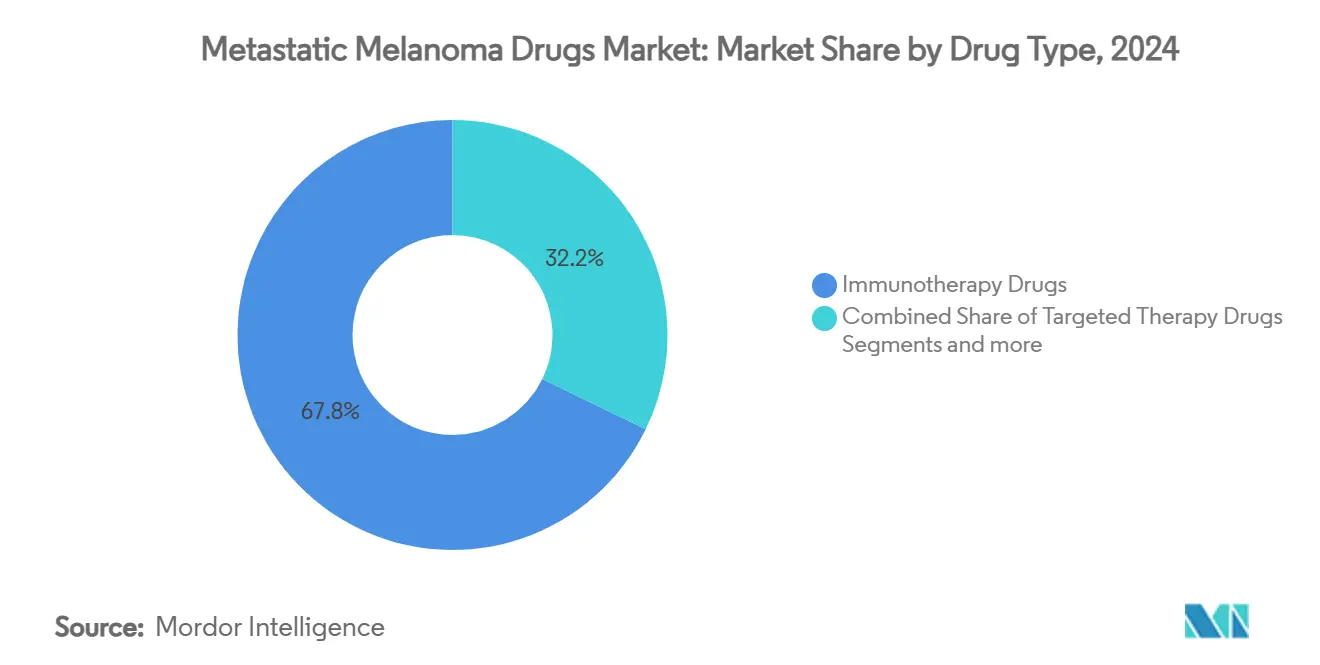
Note: Segment shares of all individual segments available upon report purchase
By Mechanism of Action: Checkpoint Innovation Expands Beyond PD-1
Immune checkpoint inhibition held 70.41% of metastatic melanoma drugs market share in 2024, justified by survival plateaus unseen with earlier treatments. Oncolytic viruses post a 10.89% CAGR, buoyed by superior intratumoral delivery techniques. Signal pathway inhibition sustains commitment via eight-year survival gains from BRAF/MEK pairs, while adoptive transfer techniques open a bespoke segment despite manufacturing constraints.
Pipeline analysis suggests multi-mechanism cocktails could surpass single-target durability, integrating viral, antibody and cell therapy components within sequential protocols. Regulators encourage such innovation by aligning tumor-agnostic approvals that streamline label expansion, quickening metastatic melanoma drugs market growth.
By Route of Administration: Intratumoral Delivery Gains Momentum
Intravenous methods represented 80.44% of 2024 spending because monoclonal antibodies dominate volumes. Nonetheless, intratumoral injections expand at 10.84% CAGR as real-time ultrasound guidance enables accurate deep organ dosing with minimal systemic exposure.
The metastatic melanoma drugs market size for intratumoral regimens remains small but accelerates as patient preference tilts toward reduced infusion center visits. Oral agents retain utility for outpatient management yet require pharmacist oversight to mitigate drug–drug interactions.
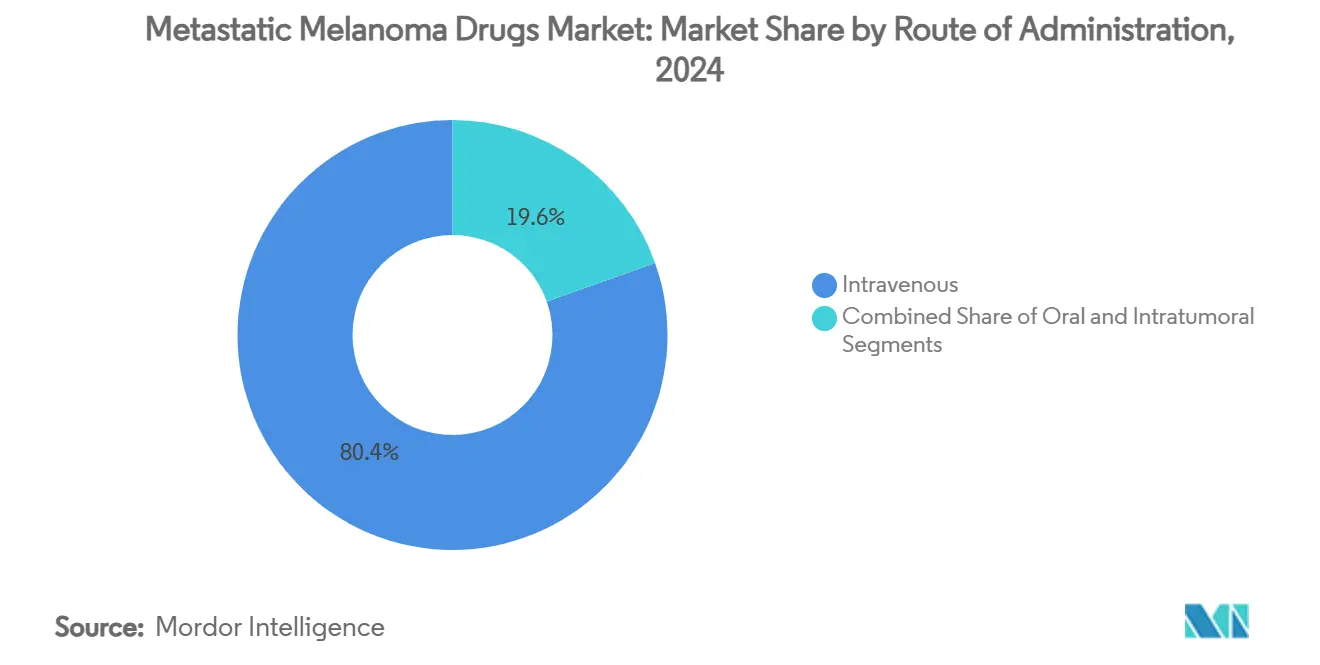
Note: Segment shares of all individual segments available upon report purchase
By Distribution Channel: Hospital Integration Transforms Access
Hospital pharmacies manage 59.91% of prescriptions given the need for sterile compounding, step-up monitoring and prompt irAE intervention. Retail channels rise at 10.94% CAGR in line with greater oral therapy share and the proliferation of medically integrated dispensing models.
Online services secure foothold through supportive medications, although biologic cold-chain needs restrict scale. The metastatic melanoma drugs market share of hospital settings may plateau as home infusion technologies mature.
Geography Analysis
North America controlled 39.94% of 2024 revenue thanks to strong payer coverage, dense trial networks and rapid FDA approvals such as lifileucel. Medicare’s negotiation policy supports continued volume growth, while academic centers pioneer combination regimens that then diffuse into the community.
Asia-Pacific logs an 11.04% CAGR driven by China’s steep incidence uptick and rising disposable income. National regulators approve domestic PD-1 agents at price points below imported therapy, broadening access. Yet real-world effectiveness lags Western outcomes due to later stage presentation, spotlighting education efforts and earlier diagnosis.
Europe benefits from EMA conditional approvals that shorten time-to-market for breakthrough agents. Local health technology assessments still cap pricing flexibility, but pan-EU initiatives promote uniform access. Conversely, Latin America’s limited trial footprint, fragmented insurance models and import duties impede state-of-the-art adoption. These disparities underscore untapped metastatic melanoma drugs market expansion potential once logistical and policy barriers ease.
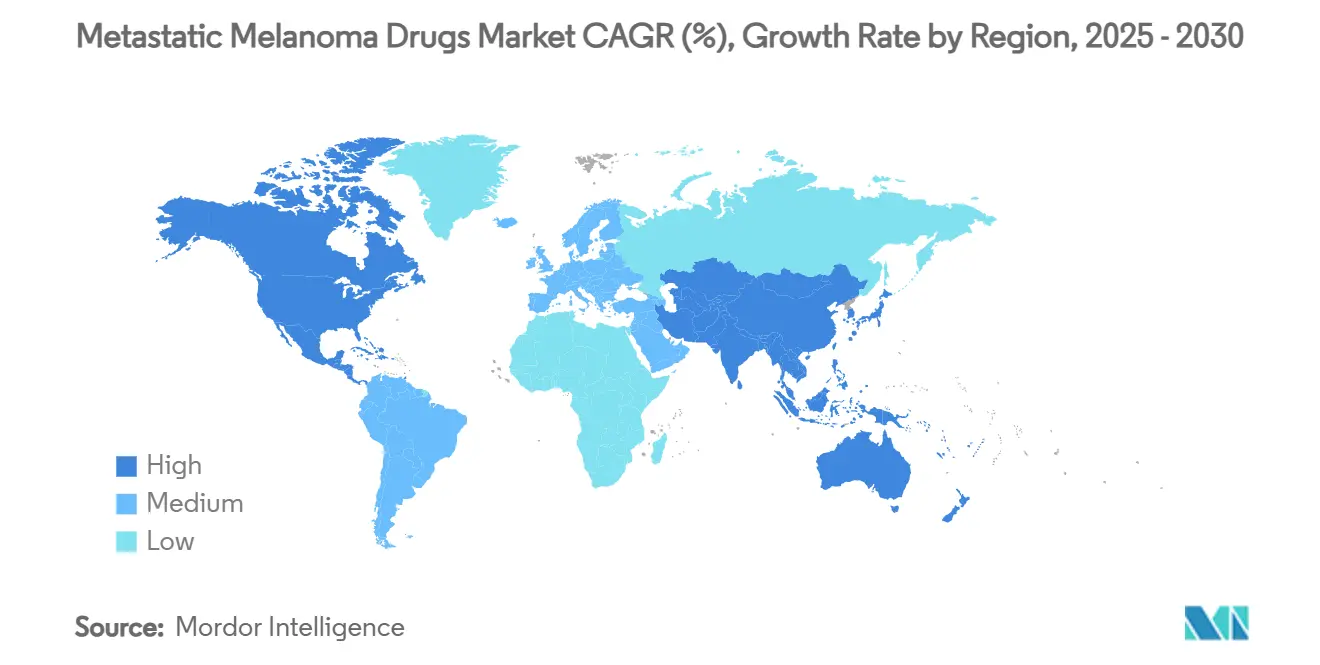
Competitive Landscape
Industry concentration remains moderate, with Bristol-Myers Squibb leading through Opdualag’s 30% first-line share and a broad immunotherapy franchise valued at USD 2.5 billion in Q4 2024 revenue. Merck leverages pembrolizumab back-bone status while stacking pipeline assets such as LM-299 and mRNA-4157 in multidimensional regimens. Iovance commands first mover advantage in cell therapy, and Replimune primes the viral therapy segment with RP1 nearing approval.
Strategic deals accelerate capability building. Bristol-Myers Squibb absorbed RayzeBio for USD 4.1 billion to diversify into radiopharmaceuticals that may rescue post-checkpoint failures. Joint ventures like Moderna–Merck apply mRNA technology to generate neoantigen vaccines that personalize immunity. AI platforms embedded across discovery workflows slash cycle times and identify resistance pathways, raising competitive hurdles for entrants lacking data infrastructure.
Barriers also stem from manufacturing sophistication. Commercial-scale TIL production demands closed-system bioreactors and cryogenic logistics, assets held by few companies. These high fixed costs raise thresholds for meaningful entry, steering the metastatic melanoma drugs market toward specialized, well-capitalized operators.
Metastatic Melanoma Drugs Industry Leaders
-
Bristol-Myers Squibb Company
-
Pfizer Inc.
-
Novartis AG
-
Merck & Co., Inc.
-
F. Hoffmann-La Roche Ltd
- *Disclaimer: Major Players sorted in no particular order
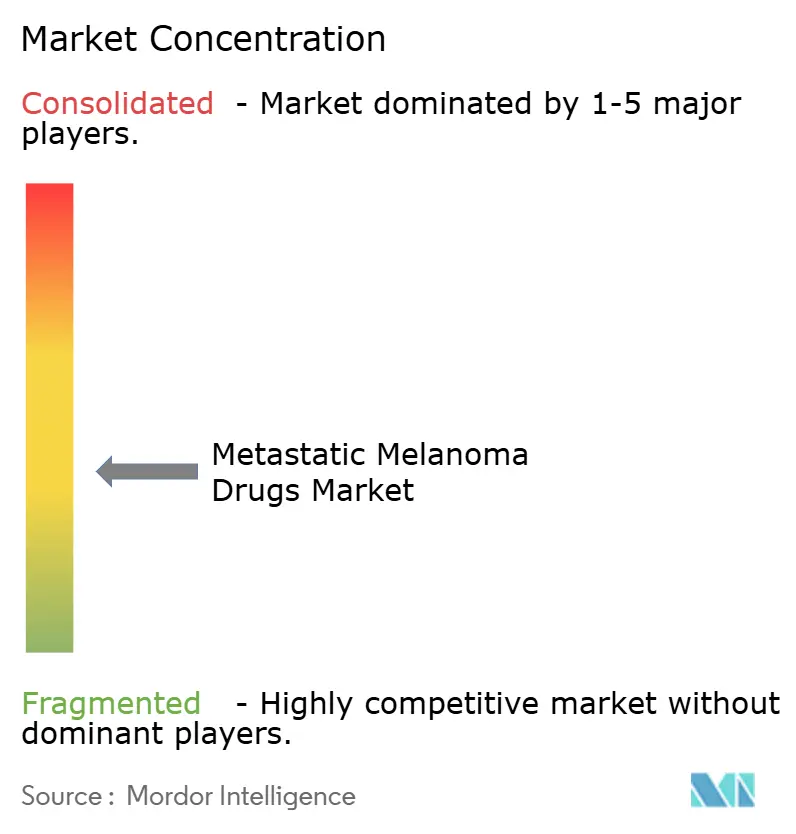
Recent Industry Developments
- January 2025: FDA granted priority review to RP1 plus nivolumab for advanced melanoma after anti-PD-1 failure, with a July 22 2025 decision date based on 33.6% response in the IGNYTE trial.
- July 2024: Iovance Biotherapeutics filed an EMA application for lifileucel, positioning the first TIL therapy for EU approval.
- June 2024: Moderna and Merck reported three-year data showing mRNA-4157 combined with pembrolizumab improved recurrence-free survival versus pembrolizumab alone.
- February 2024: FDA granted accelerated approval to lifileucel for unresectable or metastatic melanoma with a 31.5% objective response in heavily pre-treated patients.
Global Metastatic Melanoma Drugs Market Report Scope
As per the scope of the report, metastatic melanoma is a disease that occurs when the cancerous cells from the original tumor (primary tumor) get loose, spread by traveling through the lymph or blood circulation, and start a new tumor (metastatic tumor) somewhere else. The metastatic melanoma drugs are used to treat patients who are suffering from this advanced stage of melanoma. The metastatic melanoma drugs market is segmented by drug type (chemotherapy drugs, immunotherapy drugs, and targeted therapy drugs), end-user (hospitals, specialty clinics, and other end-users), and Geography (North America, Europe, Asia-Pacific, Middle East and Africa, and South America). The market report also covers the estimated market sizes and trends for 17 different countries across major regions, globally. The report offers the value (in USD million) for the above segments.
| Immunotherapy Drugs |
| Targeted Therapy Drugs |
| Chemotherapy Drugs |
| Immune Checkpoint Inhibition |
| Signal Pathway Inhibition |
| Oncolytic Virus-mediated Cytotoxicity |
| Adoptive T-Cell Transfer |
| Intravenous |
| Oral |
| Intratumoral |
| Hospital Pharmacies |
| Retail Pharmacies |
| Online Pharmacies |
| North America | United States |
| Canada | |
| Mexico | |
| Europe | Germany |
| United Kingdom | |
| France | |
| Italy | |
| Spain | |
| Rest of Europe | |
| Asia-Pacific | China |
| Japan | |
| India | |
| Australia | |
| South Korea | |
| Rest of Asia-Pacific | |
| Middle East and Africa | GCC |
| South Africa | |
| Rest of Middle East and Africa | |
| South America | Brazil |
| Argentina | |
| Rest of South America |
| by Drug Type | Immunotherapy Drugs | |
| Targeted Therapy Drugs | ||
| Chemotherapy Drugs | ||
| By Mechanism of Action | Immune Checkpoint Inhibition | |
| Signal Pathway Inhibition | ||
| Oncolytic Virus-mediated Cytotoxicity | ||
| Adoptive T-Cell Transfer | ||
| By Route of Administration | Intravenous | |
| Oral | ||
| Intratumoral | ||
| By Distribution Channel | Hospital Pharmacies | |
| Retail Pharmacies | ||
| Online Pharmacies | ||
| By Geography | North America | United States |
| Canada | ||
| Mexico | ||
| Europe | Germany | |
| United Kingdom | ||
| France | ||
| Italy | ||
| Spain | ||
| Rest of Europe | ||
| Asia-Pacific | China | |
| Japan | ||
| India | ||
| Australia | ||
| South Korea | ||
| Rest of Asia-Pacific | ||
| Middle East and Africa | GCC | |
| South Africa | ||
| Rest of Middle East and Africa | ||
| South America | Brazil | |
| Argentina | ||
| Rest of South America | ||
Key Questions Answered in the Report
How large is the metastatic melanoma drugs market in 2025?
The market reached USD 4.94 billion in 2025 and is projected to climb to USD 7.98 billion by 2030 amid a 10.07% CAGR.
Which therapy type commands the highest revenue share?
Immunotherapy maintained 67.77% of 2024 revenue owing to durable checkpoint blockade efficacy.
Which segment is growing fastest by mechanism of action?
Oncolytic virus-mediated cytotoxicity posts the fastest growth with a 10.89% CAGR through 2030.
Why is Asia-Pacific the fastest expanding region?
Sharp incidence growth, rising healthcare investment and local approvals of domestic PD-1 agents drive the region's 11.04% CAGR.
What therapy recently received the first FDA approval for TIL technology?
Lifileucel became the first tumor-infiltrating lymphocyte therapy approved for solid tumors in February 2024.
How are reimbursement changes in the United States affecting access?
Medicare's price negotiation and payment plan programs beginning in 2026 are projected to reduce oncology out-of-pocket costs by USD 6 billion.
